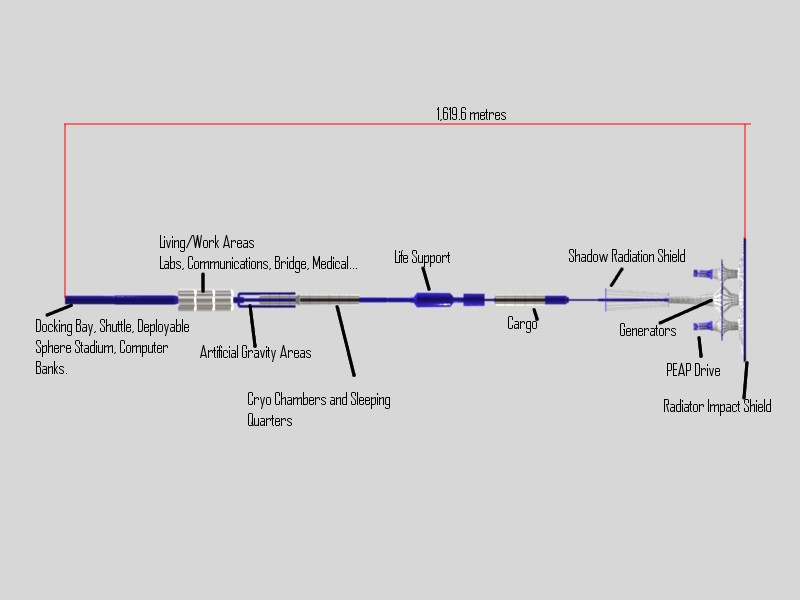Greetings!
Welcome to Scifi-Meshes.com! Click one of these buttons to join in on the fun.
Quick Links
3DExtreme Deep Space Vessel
Hello, I've been lurking for a little while I thought I might share a little project I'm starting.
For a while now I've had a fascination with spaceships that use the tractor configuration for their engine alignment. So naturally I was inspired by the Venture Star from the movie Avatar (probably the best part of the movie and deserve far more air time). I'm also drawing influence from the Icarus II from the movie Sunshine.
Anyway, I'm looking to design a spacecraft that reasonably realistic based on projected future technologies (somewhere about 100 to 200 years using a quasi-pessimistic approach). Assuming advancements in materials, antimatter production, cryo stasis technology, nano-technology and the early period production of exotic matter.
I haven't worked out the details yet but the ship will have a an eventual velocity of .4c, and capable of undertaking a 1000 year voyage.
I'm attaching some 3D mock-ups of the general design and would appreciated any constructive suggestions.
Cheers!




For a while now I've had a fascination with spaceships that use the tractor configuration for their engine alignment. So naturally I was inspired by the Venture Star from the movie Avatar (probably the best part of the movie and deserve far more air time). I'm also drawing influence from the Icarus II from the movie Sunshine.
Anyway, I'm looking to design a spacecraft that reasonably realistic based on projected future technologies (somewhere about 100 to 200 years using a quasi-pessimistic approach). Assuming advancements in materials, antimatter production, cryo stasis technology, nano-technology and the early period production of exotic matter.
I haven't worked out the details yet but the ship will have a an eventual velocity of .4c, and capable of undertaking a 1000 year voyage.
I'm attaching some 3D mock-ups of the general design and would appreciated any constructive suggestions.
Cheers!




Post edited by Mindfields on
Tagged:
Additional credits
- Icons from Font-Awesome
- Additional icons by Mickael Bonfill
- Banner background from Toptal Subtle Patterns
© Scifi-Meshes.com 2001-2024
Posts
By making the end a more rounded shape, you're more likely to get knocked slightly off course by an impact with a larger object but at least you'll only have to correct your thrust vector thingy for a short time to get back on track. Yeah, I'm all about the science I am.
Yeah, very recently though. I've not read the details of the Valkyrie yet - the droplet shield is intriguing though.
Again, it's at mock-up
Yeah, citizen's link took me there - it looks to be a useful resource.
Including Ion guns (wip), nozzle, reaction chamber, containment chamber and delivery mechanisms.
I still need to model the support structure, power cables, and shock absorbers.
The textures are temporary.
Some progress on the Radiators. Eventually they will fold up when not in use.
I've been considering that, my idea was to increase the overall surface area of the reaction chamber as a minor form of heat insulation. But after coming back to it, I'm prefer it to be smother too.
I've installed a droplet radiation system that will propel the heated droplets ahead of the ship - here's an exert I found on the Atomic Rocket Site.
I'm purposing a similar system
The second big change is the overall length of the ship, I've extended it from 1600+meters to 5000+meters. This is actually for practical reasons; there will be a huge crew (though the vast majority will be in cyro-stasis at any given time) and colony start up materials. The trip is essentially one way, so you need to bring as much as you can and make the most of it.